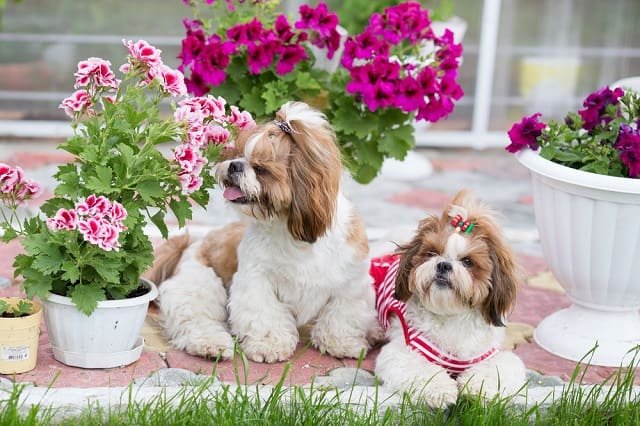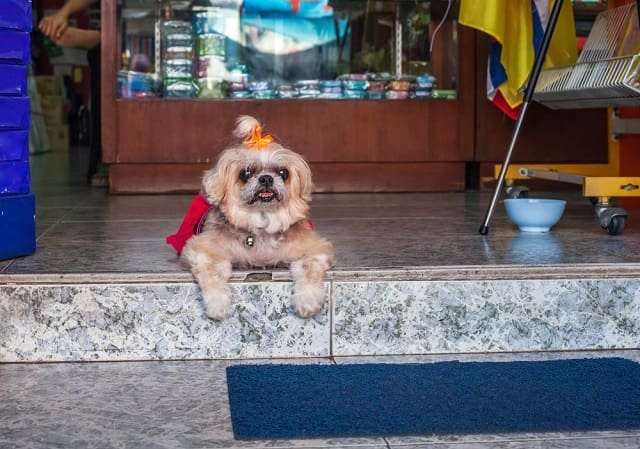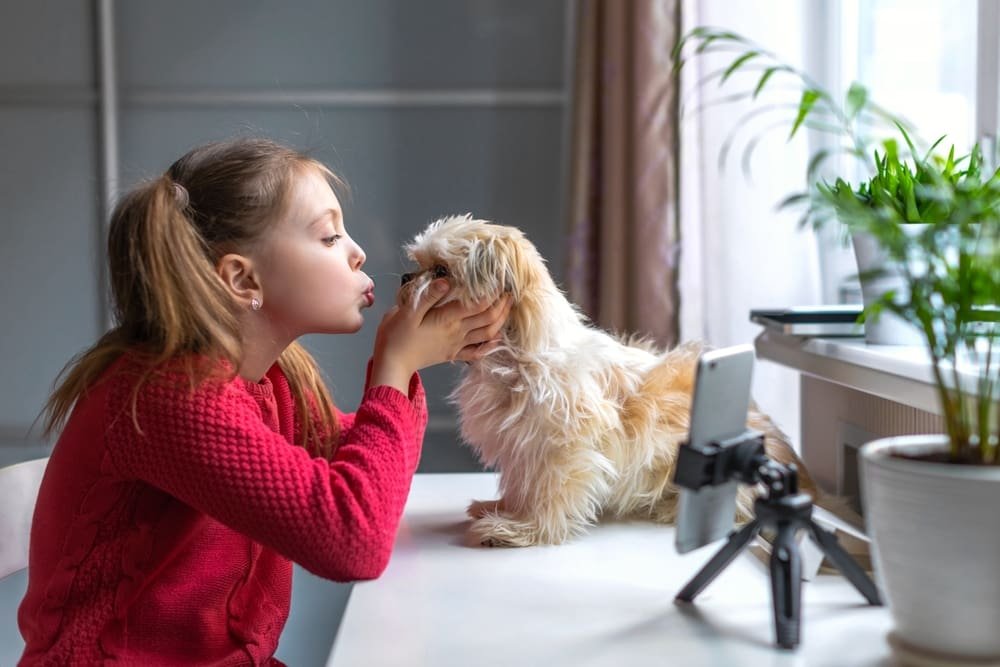Table of Contents
Are you frustrated with your hyperactive Shih Tzu causing havoc in your home? You’re not alone. Calm Your Shih Tzu From Hyper to Happy: Many Shih Tzu owners struggle with calming their energetic pups. But fear not because help is at hand. This article will explore effective techniques to calm your Shih Tzu and transform their hyper demeanor into bliss.
From tried-and-tested exercise routines to mental stimulation techniques, we will uncover the secrets to a happy, well-behaved Shih Tzu. Whether you’re dealing with a puppy or an adult dog, these methods can be tailored to suit your furry friend’s specific needs.
By understanding the underlying reasons for your Shih Tzu’s hyperactivity and implementing the right strategies, your household can become a haven of tranquility. Say goodbye to the constant barking, jumping, and running, and say hello to a more serene and contented Shih Tzu. So, let’s embark on this journey together and discover how you can transform your hyper Shih Tzu into a thrilled companion.
Understanding Hyperactivity in Shih Tzus
Shih Tzus are known for their lively and spirited personalities. However, when their energy becomes excessive and uncontrollable, it can lead to behavioral problems and stress for the dog and their owner. Understanding the root causes of hyperactivity is the first step toward finding a solution.
Several factors can contribute to a Shih Tzu’s hyperactivity. One common cause is a lack of physical exercise. Shih Tzus are an active breed that requires regular exercise to burn off excess energy. Without proper outlets for their energy, they may resort to hyperactive behaviors.
Another factor to consider is mental stimulation. Shih Tzus are intelligent dogs that thrive on mental challenges. They may become restless and hyperactive if they are not provided with enough mental stimulation. This can be particularly true for Shih Tzus, who are left alone for long periods without any form of cognitive engagement.
Additionally, certain environmental factors can contribute to hyperactivity in Shih Tzus. A chaotic or stressful household, loud noises, or sudden changes in routine can all trigger hyperactive behaviors. Identifying these triggers and creating a calm and structured environment for your Shih Tzu is essential.

The adverse effects of hyperactivity on Shih Tzus
Hyperactivity in Shih Tzus can have adverse effects on their overall well-being. Not only can it lead to behavioral issues, but it can also impact their physical health.
One of the most common adverse effects of hyperactivity is excessive barking. Shih Tzus are known for their vocal nature, but when their barking becomes incessant and uncontrollable, it can become a nuisance for the dog and their owner. This can strain the relationship between the owner and the dog and increase stress levels for both parties.
Hyperactivity can also lead to destructive behaviors. When a Shih Tzu has excess energy, it may chew on furniture, shoes, or other household items. Not only can this be costly for the owner, but it can also pose a safety risk for the dog if they ingest something harmful.
Furthermore, hyperactivity can hinder the training process. A hyperactive Shih Tzu may have difficulty focusing and paying attention, making it challenging to teach them basic obedience commands. This can lead to frustration for the owner and hinder the development of a strong bond between the dog and the human.
Identifying triggers for hyperactivity in Shih Tzus
To effectively calm your hyperactive Shih Tzu, it is crucial to identify the triggers that contribute to their hyperactivity. Every dog is unique, so observing your Shih Tzu’s behavior and noting any patterns or situations exacerbating their hyperactive tendencies is essential.
A lack of physical exercise is a common trigger for hyperactivity in Shih Tzus. If your Shih Tzu is not getting enough exercise, they may have excess energy that manifests as hyperactive behaviors. Consider increasing the duration or intensity of their exercise routine to help burn off this extra energy.
Another trigger can be a lack of mental stimulation. Shih Tzus are intelligent dogs that require mental challenges to keep them engaged and content. If your Shih Tzu lacks mental stimulation, they may become bored and resort to hyperactive behaviors. Please provide them with puzzle toys, interactive games, or training sessions to keep their minds occupied.
Additionally, certain environmental factors can trigger hyperactivity in Shih Tzus. Loud noises like thunderstorms or fireworks can cause anxiety and hyperactive behaviors. Sudden changes in routine or a chaotic household can also contribute to hyperactivity. Identify these triggers and minimize their impact on your Shih Tzu’s environment.
Creating a calm and structured environment for your Shih Tzu
Creating a calm and structured environment is essential for helping your Shih Tzu find peace and tranquility. By establishing a routine and providing a safe and secure space, you can help alleviate their hyperactivity.
Start by setting up a designated area for your Shih Tzu that is free from distractions and provides them with a sense of security. This can be a crate, a specific room, or a cozy corner with their bed and toys. Make sure this space is comfortable and inviting, allowing your Shih Tzu to retreat to it when they need some downtime.
In addition to a designated space, establish a daily routine that includes regular feeding times, exercise sessions, and mental stimulation activities. Dogs thrive on consistency, so having a structured way can help reduce their anxiety and hyperactivity. Stick to the routine as much as possible, even on weekends or during vacations, to maintain a sense of stability for your Shih Tzu.
Creating a calm environment also involves minimizing external stimuli that can trigger hyperactivity. Keep your household quiet and peaceful, especially when your Shih Tzu becomes hyperactive. Use curtains or blinds to block out excessive external stimuli, and play calming music or white noise to drown out loud noises.
A calm, structured environment sets the foundation for a more peaceful and contented Shih Tzu. The next step is incorporating exercise and mental stimulation into their daily routine.

Exercise and mental stimulation for reducing hyperactivity
Exercise is a crucial component in calming a hyperactive Shih Tzu. Regular physical activity helps burn off excess energy and promotes mental well-being. However, tailoring the exercise routine to your Shih Tzu’s needs and physical capabilities is essential.
Start by incorporating daily walks into your Shih Tzu’s routine. Aim for at least 30 minutes of brisk walking each day. This will give them physical exercise to explore their surroundings and satisfy their curiosity. If your Shih Tzu has more energy to burn, consider adding additional walks throughout the day or engaging in more vigorous activities such as jogging or playing fetch.
In addition to walks, engage your Shih Tzu in interactive play sessions. Use toys that encourage mental stimulation, such as puzzle or treat-dispensing toys. These toys require your Shih Tzu to use their problem-solving skills, providing physical and psychological exercise. Incorporate training sessions into playtime to further challenge their minds and reinforce obedience commands.
Another effective way to mentally stimulate your Shih Tzu is through scent games. Hide treats or toys around the house and encourage your Shih Tzu to use their nose to find them. This taps into their instinct to sniff and search, providing mental stimulation and fun activity for your hyperactive pup.
Remember, each dog is unique, so it may take some trial and error to find the right balance of exercise and mental stimulation for your Shih Tzu. Observe their behavior and adjust their routine accordingly. Over time, you will discover the perfect combination that helps calm their hyperactivity and promotes happiness.
Training techniques to promote calmness in your Shih Tzu
Training is an essential aspect of calming a hyperactive Shih Tzu. By teaching them basic obedience commands and providing structure, you can help them channel their energy in a more controlled manner.
Start by teaching your Shih Tzu basic commands such as “sit,” “stay,” and “down.” These commands guide them and create boundaries, helping reduce their hyperactivity. Use positive reinforcement techniques, such as treats and praise, to reward your Shih Tzu when they exhibit calm behavior or successfully follow a command.
Incorporate short training sessions into your Shih Tzu’s daily routine. Aim for sessions that last no longer than 10-15 minutes, as their attention span may be limited. Be patient and consistent, and gradually increase the difficulty of the commands as your Shih Tzu becomes more proficient.
Another effective training technique is the use of calming cues. These cues can signal to your Shih Tzu that it is time to relax and be calm. Calming cues include a specific word or phrase, a gentle touch, or a specific action, such as sitting on their designated bed. Use these cues consistently to reinforce the desired behavior and help your Shih Tzu associate them with calmness.
Remember, training should be a positive and enjoyable experience for you and your Shih Tzu. Approach it with patience, consistency, and a gentle demeanor. With time and practice, you will see improvements in your Shih Tzu’s ability to remain calm and focused.

Natural remedies and supplements for calming hyperactive Shih Tzus
In addition to exercise, mental stimulation, training, natural medications, and supplements can help calm hyperactive Shih Tzus. These remedies can be used with behavioral strategies to promote relaxation and reduce anxiety.
One popular natural remedy is the use of aromatherapy. Certain scents, such as lavender or chamomile, have calming properties that can help soothe a hyperactive Shih Tzu. Use essential oils specifically formulated for dogs, and diffuse them in the room where your Shih Tzu spends most of their time. Alternatively, you can apply diluted essential oils to a bandana or collar for your Shih Tzu to wear.
Another option is the use of herbal supplements. There are various herbal supplements available that are specifically formulated to promote calmness in dogs. These supplements often contain chamomile, valerian root, or passionflower ingredients. Consult your veterinarian to determine the appropriate dosage and most suitable accessory for your Shih Tzu.
It is important to note that natural remedies and supplements should not be used as a standalone solution. They should be used with behavioral strategies, exercise, and training to achieve the best results. Always consult your veterinarian before introducing new supplements or remedies to your Shih Tzu’s routine.
Seeking professional help for severe cases of hyperactivity
While the techniques mentioned in this article can be effective for most cases of hyperactivity in Shih Tzus, professional service may be necessary. If your Shih Tzu’s hyperactivity is severe, persistent, or causing significant distress, it is essential to seek guidance from a professional dog trainer or a veterinarian with expertise in behavior.
A professional can assess your Shih Tzu’s behavior, identify any underlying issues, and provide a tailored plan to address their hyperactivity. They may recommend additional training techniques, behavior modification strategies, or medication in severe cases. Remember, seeking professional help is not a sign of failure but rather a proactive step towards helping your Shih Tzu find peace and happiness.
Maintaining a consistent routine and lifestyle for a calm Shih Tzu
Once you have implemented the various techniques and strategies to calm your hyperactive Shih Tzu, it is essential to maintain a consistent routine and lifestyle. Dogs thrive on structure and predictability, so maintaining a stable environment will help them retain their newfound calmness.
Stick to the daily routine that you have established, including regular exercise sessions, mental stimulation activities, and training sessions. Ensure that your Shih Tzu’s environment remains calm and free from triggers contributing to hyperactivity. Consistency is vital in reinforcing the desired behavior and maintaining a calm and contented Shih Tzu.
Additionally, continue to monitor and assess your Shih Tzu’s behavior. Observe any changes or signs of hyperactivity and adjust their routine or strategies accordingly. Remember, each dog is unique, and what works for one Shih Tzu may not work for another. Be flexible and willing to adapt your approach to suit Shih Tzu’s specific needs.
Conclusion: Calm Your Shih Tzu
Calming a hyperactive Shih Tzu may require time, patience, and various strategies. By understanding the underlying causes of hyperactivity, creating a calm and structured environment, providing exercise and mental stimulation, implementing training techniques, and considering natural remedies and supplements, you can help your Shih Tzu find peace and happiness.
Remember, every step to calming your hyperactive Shih Tzu builds a stronger bond and creates a more harmonious household. You can transform your hyper Shih Tzu into a thrilled and contented companion with love, consistency, and proper techniques.
